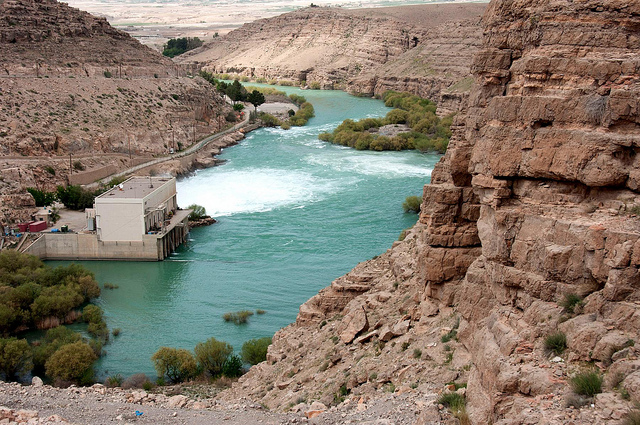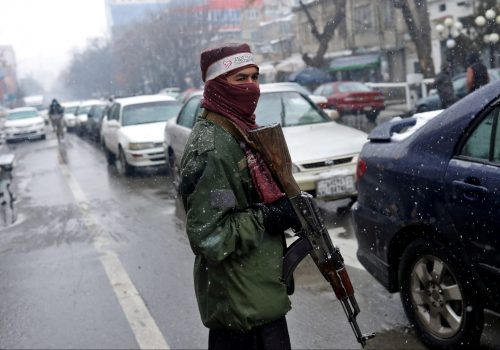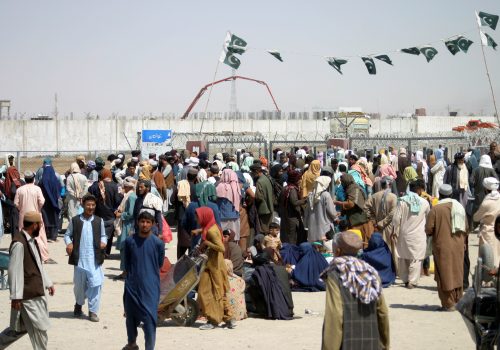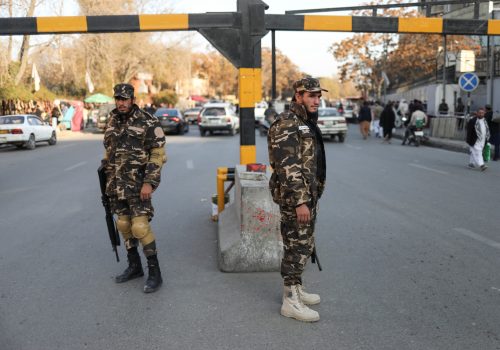For the fourth time in almost half a century, the people of Afghanistan are experiencing acute poverty. Among the causes are the sudden loss of livelihoods and income as a result of crippling international sanctions, frozen financial assets, and a man-made recession imposed on the country’s aid-dependent economy after the fall of Kabul last August.
However, as the world lends a hand through the United Nations and international aid organizations and by bypassing the Taliban administration, preventing an imminent humanitarian catastrophe cannot be achieved just by throwing more money at the problem or isolating the new regime. Instead, a durable and Afghan-owned solution will need a two-pronged policy approach involving the Taliban and key Afghan and foreign stakeholders through enhanced engagement and a political action plan to address key shortcomings, but also broaden the scope and impact of governance.
While the multibillion-dollar humanitarian effort currently underway is essential and must reach destitute communities and families for as long as necessary in an effective and accountable manner, it is neither a sustainable model nor a long-term solution for a country of more than thirty-five million people struggling to find peace and stability after four decades of conflict.
Raising an unprecedented sum of eight billion dollars under United Nations (UN) auspices this year to feed Afghans and offer essential services is a momentous undertaking that is appreciated by Afghans. That said, this cannot be a substitute for seeking a permanent solution to the unfolding crisis.
A parallel effort is also needed on the political front to overcome governance barriers, build trust, and strengthen domestic resilience as well as develop a consensus on the way forward, thus reducing or eliminating the impact of the sanctions regime.
Doing so would partly alleviate the severe external financial and banking restrictions brought upon the fragile Afghan system since the abrupt palace-triggered coup that led to the fall of the “republic” and recapture of Kabul by the Taliban last August. It may also change the dynamics that have dictated relations between the world’s major donors and Kabul’s Taliban rulers – some of whom are still on UN and US terrorism blacklists.
Foreign aid comprised over 40 percent of Afghanistan’s GDP in 2020, with budgetary aid specifically representing more than 70 percent of the government’s budget prior to the fall of Kabul. Today, Afghanistan receives no bilateral or multilateral foreign aid.
Two-track engagement is needed
A two-track Afghan-led effort is needed to, on one hand, stave off the worst effects of sanctions on more than 60 percent of the acutely malnourished and 95 percent of the impoverished population, and on the other hand, address key human/women’s rights concerns, political representation shortcomings, and governance challenges facing the country after forty-three years of war and displacement.
Afghanistan’s first mega humanitarian shockwave was felt between 1978 and 1992, during the Soviet occupation and communist rule when more than one third of the population (estimated then at around fifteen million) were displaced, and more than one million people died. The second blow was felt during the post-communist factional power struggle that centered in and around Kabul and resulted in serious loss of lives and another wave of displacement. The third crisis hit Afghans during the first round of Taliban rule in the mid-1990s, highlighted by armed resistance, implantation of terror groups such as al-Qaeda, and an ostracized Taliban regime.
New political overtures
Encouraged by circles within the Taliban, signs are emerging that the country’s domestic political actors are engaged in a new round of subtle trust-building aimed at agreeing to a political roadmap leading to a more representative and acceptable political order. Different ideas have been put forth for discussion in the past few days, all of which are advocating for wider intra-Afghan consultations but have yet to agree on the process and mechanisms to reach a shared outcome.
While the Taliban have met twice with an exiled resistance front led by Ahmad Massoud in the past six months (with no apparent results), there are ongoing consultations with Kabul-based politicians such as ex-President Hamid Karzai, former Chief Executive Abdullah Abdullah, ex-mujahideen leader Gulbudin Hekmatyar, ethnic political and civil society leaders, and through smaller-scale intra-Afghan exchange channels such as the Oslo conference last week that act as exchange and trust-building platforms.
While the objective is to initiate Afghan-owned talks that involve the Taliban and other stakeholders that allow for an exchange of ideas and proposals concerning governance, human rights, and constitutional and economic challenges facing the country, the process is still young and does not include all relevant forces yet. Key proposals and recommendations so far include:
- Formalizing a national consultation process.
- Broadening the scope and representation of relevant socio-political and ethnic constituencies under a single umbrella or Shura (council).
- Agreeing to work on a legal document or draft a new constitution.
- Considering legitimization mechanisms for consultations and decision making, be it a Shura, a Loya Jirga, or some form of plebiscite at the national level.
- Prioritizing key issues such as human rights, access for all genders to education and employment, minority rights, and enhancing governance standards and capacities.
- Addressing violations or allegations of abductions, curtailment of freedom of expression, and human rights abuses.
- Assessing best options for enhancing domestic and international legitimacy leading to recognition via an Afghan-led mechanism or UN-sponsored international conference model.
On the economic side, while efforts are underway to build a viable humanitarian-financial corridor, new technical solutions are being floated inside and outside Afghanistan to improve the impact of aid and combat hunger and poverty irrespective of Taliban involvement. They include:
- Gradually injecting liquidity into the economy by relaxing legal banking and foreign exchange restrictions.
- Creating a trust fund to administer existing civil service salary payments and backpay.
- Making strategic use of frozen assets to keep the currency stable and inflation under check.
- Enabling trading and small-scale investment opportunities.
- Supporting the commercial and small business sector.
- Enhancing accountability and sustainability by reducing future excessive aid dependency.
While some look at the international community to be the sole driver of change and adjustment, as US Special Envoy for Afghanistan Thomas West said last week, it is Afghans who will need to decide on the process and mechanisms that work best, pointing to the Jirga as an option.
Afghans in general are aware that inside the country the Taliban are in the driver’s seat, but the vehicle cannot go far without having other major constituencies onboard as part of a new social contract. The first test on the political front will be Taliban readiness to engage and pursue a consultative process leading to a national roadmap, a mechanism and governance benchmarks, and specific solutions and alternatives on the economic side involving all key stakeholders.
We owe such a process to millions of Afghans who are needlessly suffering and being victimized.
Omar SAMAD is a former Afghan Ambassador to France and Canada, Government Advisor and spokesperson. He is currently a non-resident Senior Fellow at Atlantic Council and CEO of Silkroad Consulting LLC.

The South Asia Center is the hub for the Atlantic Council’s analysis of the political, social, geographical, and cultural diversity of the region. At the intersection of South Asia and its geopolitics, SAC cultivates dialogue to shape policy and forge ties between the region and the global community.
Related content
Image: The Kajaki Reservoir in Afghanistan, which serves as a holding tank for the Kajaki Dam power house that supplies hydroelectric power for southern Afghanistan. Photo: US Army Corps of Engineers



